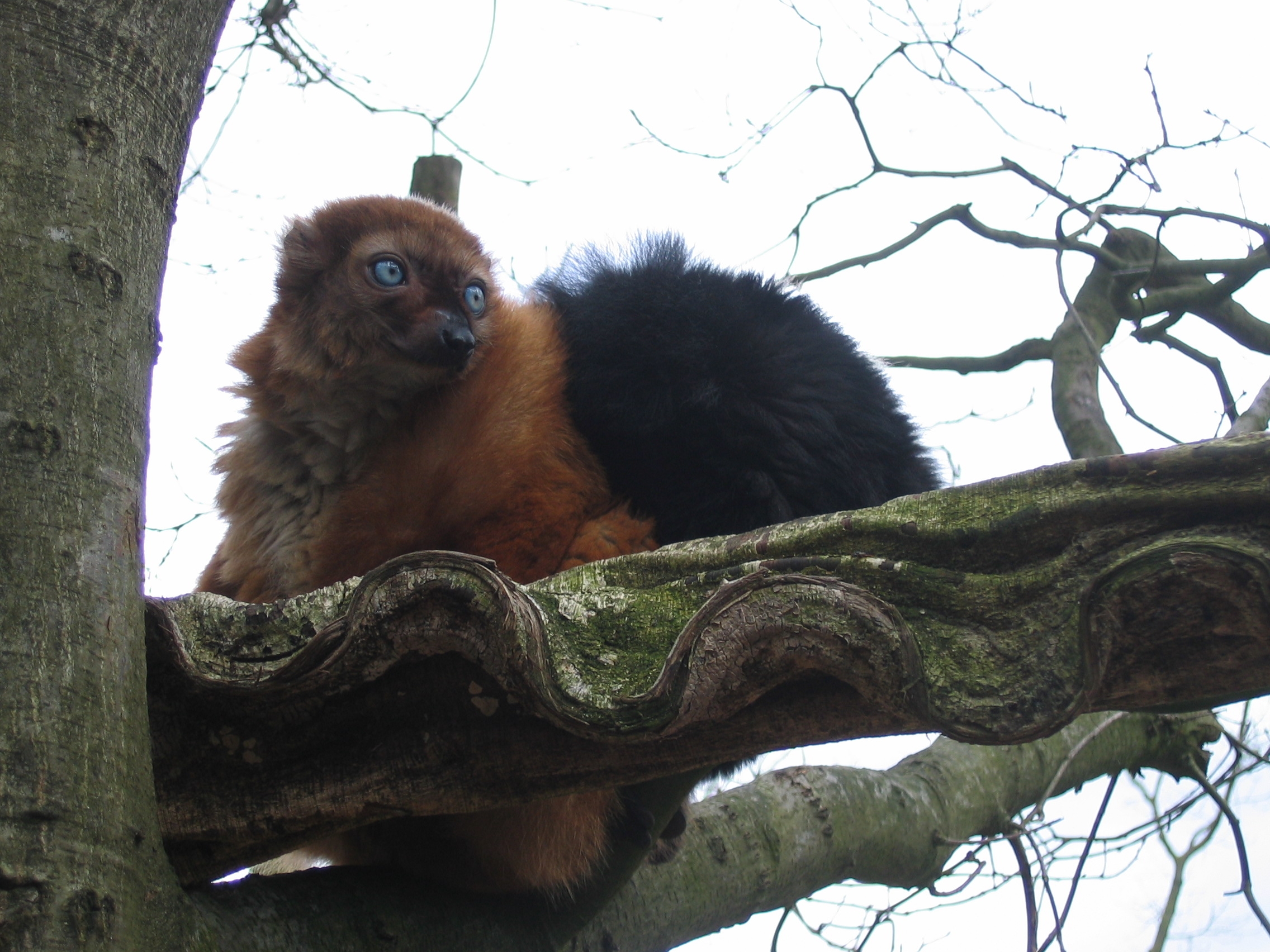- Blue-eyed Black Lemur
Taxobox
name = Blue-eyed Black LemurMSW3 Groves|pages=115]

status = CR
status_system = iucn2.3
status_ref = IUCN2006|assessors=Ganzhorn, J. & Members of the Primate Specialist Group 2000|year=2000|id=8211|title=Eulemur macaco "ssp." flavifrons|downloaded=2006-06-27 ]
regnum =Animal ia
phylum =Chordata
classis =Mammal ia
ordo =Primate s
familia =Lemuridae
genus = "Eulemur "
species = "E. macaco"
subspecies = "E. m. flavifrons"
trinomial = "Eulemur macaco flavifrons"
trinomial_authority = Gray, 1867The Blue-eyed Black Lemur ("Eulemur macaco flavifrons"), also known as Sclater's Black Lemur, is a
subspecies ofBlack Lemur . It can attain a body length of 39-45 cm, a tail length of 51-65 cm- a total length of 90-100 cm, and a weight of 1.8-1.9 kg.cite book|title=Lemurs of Madagascar|author=Mittermeier, RA|page=291|year=2006|id = ISBN 1-881173-88-7] Being aprimate , it has strong hands with palms like a human, which have a rubbery texture to give it a firm grip on branches. Its tail is longer than its body and non-prehensile.Like many of the
species and subspecies in the "Eulemur " genus, the Blue-Eyed Black Lemur issexually dichromatic . Males are solid black in color, with the hairs sometimes tinged brown at the roots. Females are reddish-brown in color with their underside and outline of their face a lighter tan. They have a dark brown or gray muzzle and the back of their hands and feet are a similar dark color. Both genders have blue eyes, hence the common name, and are one of the only primates other than humans to consistently have blue eyes. The eyes can range in color from shocking electric blue, a light sky-glue, or a softer gray-blue.Although the Blue-Eyed Black Lemur ("E. m. flavifrons") and the Common Black Lemur ("E. m. macaco") look similar, they can be differentiated by the blue eyes and lack of prominent ear tufts of this subspecies, while "E. m. macaco" has orange-red eyes and long, spiky cheek hairs. In the Manongarivo Special reserve, where the range of the two subspecies overlap, there is report of hybridization between the two subspecies, but the resulting offspring always have orange eyes.
Behavior
This
true lemur hasn't been studied intensively in the wild, but it is known to be fairly social. Group sizes vary dramatically with numbers of 2-15 individuals having been observed, although 7-10 individuals being the most common. Females are dominant as in most lemur species, and there are usually more males than females in each social group. The Blue-Eyed Black Lemur is thought to bepolygynous . Females give birth to one or two offspring in June or July, after a gestation of 120 to 129 days. The young are weaned after about 5-6 months, and reach maturity at about 2 years of age. It may live between 15-30 years in captivity, with little data recorded on their longevity in the wild. It demonstrates acathemeral activity pattern, being awake sporadically throughout the day. The occasional nighttime activities are thought to be based on the intensity of the moonlight.The Blue-Eyed Black Lemur communicates with scent-marking, vocalizations, and perhaps some facial expressions. Scent marking is an important means of communication as with most lemur species. Both genders will mark on trees with
anogenital glands, while males will also mark using wrist and palm glands by rubbing and twisting them against leaves, twigs or branches. Males also use a scent gland on the top of their head to mark, lowering their head and rubbing in quick sliding motions. [ [http://lemur.duke.edu/animals/blueeyed/social.php Duke Lemur Center] ] Little is known of its vocalizations, but it has been observed making a variety of grunts, chirps, barks and clicks. The males are known to make a sharp 'scree' when distressed.The Blue-Eyed Lemur has also been observed to be a highly aggressive subspecies. There is frequent infighting between troop members, especially during the breeding and birthing seasons. In captivity it has been observed committing infanticide against other species of lemurs, a behavior that is usually uncommon, especially in captivity.
Diet
Fruit, pollen, and nectar make up the bulk of this lemur's diet. During the dry season when food is scarce it may eat leaves, seeds and berries and rarely insects. It may also raid farmlands and eat some of the crops, which may lead to it being shot by farmers.
The Blue-eyed Black Lemur helps propagate many rain forest plants. Since it digests the flesh but not the seeds of the fruits it eats, it spreads the seeds of more than 50 different plant species (deposited in a fresh pile of fertilizer), and some plants may have evolved specifically to be dispersed by this lemur. The Blue-eyed Black Lemur also pollinates many plants while it eats nectar and pollen from the plants' flowers.
Habitat
The Blue-Eyed Black Lemur inhabits primary and secondary sub-tropical moist and dry forests in the northwestern tip of
Madagascar . Its range extends from the Andranomalaza River in the north, to the Maevarano River in the south. Some areas where it can readily be seen are in the forests south of Maromandia near Antananarivo and Antsiranana. It may also be seen in the remaining forest patches of the Sahamalaza Peninsula, such as the Ankarafa forest. Unfortunately, it is not currently found in any protected forests on the island.Conservation
Humans have cut down almost all of this subspecies' habitat to clear farm land. As a result, the Blue-eyed Black Lemur is nearly extinct in the wild. The Blue-eyed Black Lemur subspecies is listed on Appendix I of
CITES , and is critically endangered. As few as 1,000 individuals are thought to remain in the wild, largely due to slash and burn habitat destruction, as well as a mild threat from hunting problems- Killing them to sell their meat as a delicacy in China.References
*C. Birkinshaw. Biotropica. 2001. 33(3): 478–486.
*Birkinshaw, et al. Folia Primatology (Basel). 1998. 69(5):252-259.
Wikimedia Foundation. 2010.
